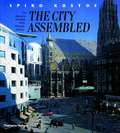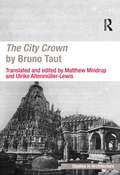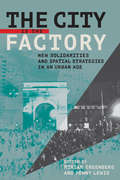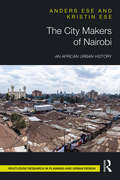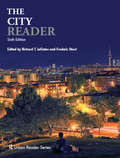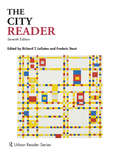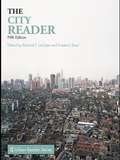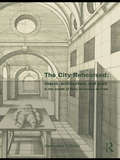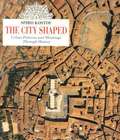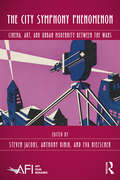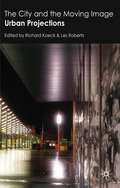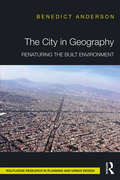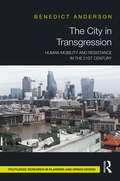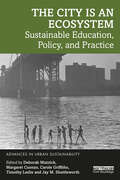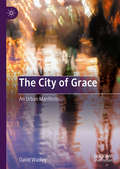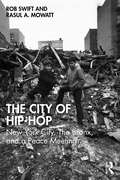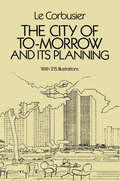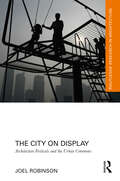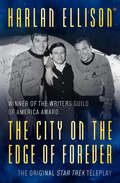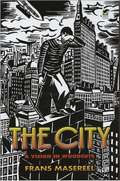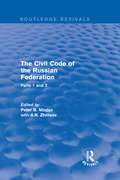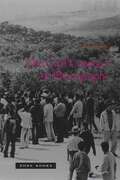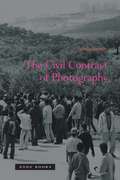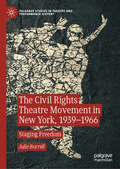- Table View
- List View
The City Assembled: The Elements of Urban Form Through History
by Spiro Kostof Greg Castillo Richard TobiasThe City Assembled is a history of the elements of cities: streets, public places, urban divisions (religious, political, and social), and the frontiers of city and countryside. Kostof follows the evolution of city components to modern times. He discusses "urban process": the effect on cities of natural disasters like the Great Fire of London and the Lisbon earthquake, war, and comprehensive redevelopment, compared with traditional patterns of growth and change. The current recovery from modernist extremes has made us look again at what we treasure in traditional urban life, and how we can recharge the old forms with contemporary common sense. Over 300 drawings, prints, paintings, and photographs help to tell the story, illustrating both patterns and uses, from the colonnaded streets of ancient Palmyra to gentrified London squares. A fitting testament to the wide-ranging intellect of Professor Kostof, The City Assembled is at once an exercise in architectural and social history, a case study for the present, and a pointer for the future. 346 illustrations, 40 in color.
The City Crown by Bruno Taut (Ashgate Studies in Architecture)
by Matthew Mindrup Ulrike Altenmüller-LewisThis book is the first English translation of the German architect Bruno Taut’s early twentieth-century anthology Die Stadtkrone (The City Crown). Written under the influence of World War I, Taut developed The City Crown to promote a utopian urban concept where people would live in a garden city of ’apolitical socialism’ and peaceful collaboration around a single purpose-free crystalline structure. Taut’s proposal sought to advance the garden city idea of Ebenezer Howard and rural aesthetic of Camillo Sitte’s urban planning schemes by merging them with his own ’city crown’ concept. The book also contains contributions by the Expressionist poet Paul Scheerbart, the writer and politician Erich Baron and the architectural critic Adolf Behne. Although the original German text was republished in 2002, only the title essay of The City Crown has previously been translated into English. This English translation of Taut’s full anthology, complete with all illustrations and supplementary texts, fills a significant gap in the literature on early modern architecture in Germany and the history of urban design. It includes a translators’ preface, introduction and afterword to accompany the original composition of essays, poems, designs and images. These original texts are accompanied by illustrations of Taut’s own designs for a utopian garden city of 300,000 inhabitants and over 40 additional historic and contemporary examples. The new preface to The City Crown explains the premise for the English translation of Taut’s anthology, its organization and the approaches taken by the translators to maintain the four different voices included in the original work. Matthew Mindrup’s introduction critically examines the professional and intellectual developments leading up to and supporting Bruno Taut’s proposal to advance the English garden city concept with a centralized communal structure of glass, the city crown. Through the careful examination of original
The City Is the Factory: New Solidarities and Spatial Strategies in an Urban Age
Urban public spaces, from the streets and squares of Buenos Aires to Zuccotti Park in New York City, have become the emblematic sites of contentious politics in the twenty-first century. As the contributors to The City Is the Factory argue, this resurgent politics of the square is itself part of a broader shift in the primary locations and targets of popular protest from the workplace to the city. This shift is due to an array of intersecting developments: the concentration of people, profit, and social inequality in growing urban areas; the attacks on and precarity faced by unions and workers' movements; and the sense of possibility and actual leverage afforded by local politics and the tactical use of urban space. Thus, "the city"—from the town square to the banlieu—is becoming like the factory of old: a site of production and profit-making as well as new forms of solidarity, resistance, and social reimagining.We see examples of the city as factory in new place-based political alliances, as workers and the unemployed find common cause with "right to the city" struggles. Demands for jobs with justice are linked with demands for the urban commons—from affordable housing to a healthy environment, from immigrant rights to "urban citizenship" and the right to streets free from both violence and racially biased policing. The case studies and essays in The City Is the Factory provide descriptions and analysis of the form, substance, limits, and possibilities of these timely struggles.ContributorsMelissa Checker, Queens College and the Graduate Center of the City University of New York; Daniel Aldana Cohen, University of Pennsylvania; Els de Graauw, Baruch College, City University of New York; Kathleen Dunn, Loyola University ChicagoShannon Gleeson, Cornell University; Miriam Greenberg, University of California, Santa Cruz; Alejandro Grimson, Universidad de San Martín (Argentina); Andrew Herod, University of Georgia; Penny Lewis, Joseph S. Murphy Institute for Worker Education and Labor Studies, City University of New York; Stephanie Luce, Joseph S. Murphy Institute for Worker Education and Labor Studies, City University of New York; Lize Mogel, artist and coeditor of An Atlas of Radical Cartography; Gretchen Purser, Maxwell School of Citizenship and Public Affairs, Syracuse University
The City Makers of Nairobi: An African Urban History
by Anders Ese Kristin EseThe City Makers of Nairobi re-examines the history of the urban development of Nairobi in the colonial period. Although Nairobi was a colonial construct with lasting negative repercussions, the African population’s impact on its history and development is often overlooked. This book shows how Africans took an active part in making use of the city and creating it, and how they were far from being subjects in the development of a European colonial city. This re-interpretation of Nairobi’s history suggests that the post-colonial city is the result of more than unjust and segregative colonial planning. Merging historical documentation with extensive contemporary urban theory, this book provides in-depth knowledge of the key historical roles played by locals in the development of their city. It argues that the idea of agency, a popular inroad to urban development today, is not a current phenomenon but one that has always existed with its many social, spatial, and physical ramifications. This is an ideal read for upper-level undergraduate and graduate students studying the history of urban development and theories, providing an in-depth case study for reference. The City Makers of Nairobi broaches interdisciplinary themes important to urban planners, social scientists, historians, and those working with popular settlements in cities across the world.
The City Reader (Routledge Urban Reader Series)
by Frederic Stout Richard T. LeGatesThe sixth edition of the highly successful The City Reader juxtaposes the very best classic and contemporary writings on the city to provide the comprehensive mapping of the terrain of Urban Studies and Planning old and new. The City Reader is the anchor volume in the Routledge Urban Reader Series and is now integrated with all ten other titles in the series. This edition has been extensively updated and expanded to reflect the latest thinking in each of the disciplinary areas included and in topical areas such as compact cities, urban history, place making, sustainable urban development, globalization, cities and climate change, the world city network, the impact of technology on cities, resilient cities, cities in Africa and the Middle East, and urban theory. The new edition places greater emphasis on cities in the developing world, globalization and the global city system of the future. The plate sections have been revised and updated. Sixty generous selections are included: forty-four from the fifth edition, and sixteen new selections, including three newly written exclusively for The City Reader. The sixth edition keeps classic writings by authors such as Ebenezer Howard, Ernest W. Burgess, LeCorbusier, Lewis Mumford, Jane Jacobs, and Louis Wirth, as well as the best contemporary writings of, among others, Peter Hall, Manuel Castells, David Harvey, Saskia Sassen, and Kenneth Jackson. In addition to newly commissioned selections by Yasser Elshestawy, Peter Taylor, and Lawrence Vale, new selections in the sixth edition include writings by Aristotle, Peter Calthorpe, Alberto Camarillo, Filip DeBoech, Edward Glaeser, David Owen, Henri Pirenne, The Project for Public Spaces, Jonas Rabinovich and Joseph Lietman, Doug Saunders, and Bish Sanyal. The anthology features general and section introductions as well as individual introductions to the selected articles introducing the authors, providing context, relating the selection to other selection, and providing a bibliography for further study. The sixth edition includes fifty plates in four plate sections, substantially revised from the fifth edition.
The City Reader (Routledge Urban Reader Series)
by Frederic Stout Richard T. LeGatesThe seventh edition of the highly successful The City Reader juxtaposes the very best classic and contemporary writings on the city. Sixty-three selections are included: forty-five from the sixth edition and eighteen new selections, including three newly written exclusively for The City Reader. The anthology features a Prologue essay on "How to Study Cities", eight part introductions as well as individual introductions to each of the selected articles. The new edition has been extensively updated and expanded to reflect the latest thinking in each of the disciplinary and topical areas included, such as sustainable urban development, globalization, the impact of technology on cities, resilient cities, and urban theory. The seventh edition places greater emphasis on cities in the developing world, the global city system, and the future of cities in the digital transformation age. While retaining classic writings from authors such as Lewis Mumford, Jane Jacobs, and Louis Wirth, this edition also includes the best contemporary writings of, among others, Peter Hall, Manuel Castells, and Saskia Sassen. New material has been added on compact cities, urban history, placemaking, climate change, the world city network, smart cities, the new social exclusion, ordinary cities, gentrification, gender perspectives, regime theory, comparative urbanization, and the impact of technology on cities. Bibliographic material has been completely updated and strengthened so that the seventh edition can serve as a reference volume orienting faculty and students to the most important writings of all the key topics in urban studies and planning. The City Reader provides the comprehensive mapping of the terrain of Urban Studies, old and new. It is essential reading for anyone interested in studying cities and city life.
The City Reader Fifth Edition
by Frederic Stout Richard T. LegatesThe fifth edition of the highly successful City Reader juxtaposes the best classic and contemporary writings on the city. It contains fifty-seven selections including seventeen new contributions by experts including Elijah Anderson, Robert Bruegmann, Michael Dear, Jan Gehl, Harvey Molotch, Clarence Perry, Daphne Spain, Nigel Taylor, Samuel Bass Warner, and others - some of which have been newly written exclusively for The City Reader. Classic writings from Ebenezer Howard, Ernest W. Burgess, LeCorbusier, Lewis Mumford, Jane Jacobs and Louis Wirth, meet the best contemporary writings of Sir Peter Hall, Manuel Castells, David Harvey, Kenneth Jackson. This edition of The City Reader has been extensively updated and expanded to reflect the latest thinking in each of the disciplinary areas included and in topical areas such as sustainable urban development, climate change, globalization, and the impact of technology on cities. The plate sections have been extensively revised and expanded and a new plate section on global cities has been added. The anthology features general and section introductions and introductions to the selected articles. New to the fifth edition is a bibliography listing over 100 of the top books for those studying Cities.
The City Rehearsed: Object, Architecture, and Print in the Worlds of Hans Vredeman de Vries (The Classical Tradition in Architecture)
by Christopher HeuerThe City Rehearsed offers an entirely new perspective on printed architecture in early modern Europe through the lens of Hans Vredeman de Vries. It probes the geographical encounters of dozens of engravings with contemporary texts on architecture, theatre, urbanism, art collecting, even ethnography. The Netherlandish polymath Hans Vredeman de Vries (1526-1609) devoted his entire career to the production of imaginary architecture. Painter, architect, rhetorician, perspective theorist, festival designer, and draughtsman, Vredeman was active in Antwerp, Amsterdam, and Prague, where he designed a mysterious body of architectural prints, works which by the seventeenth century had influenced buildings from Tallinn to Peru. Including Scenographiae (1560), and Perspective (1604-5), Vredeman’s strange publications were among the most widely-distributed "Renaissance" books on building and vision, shipped to England, Spain and even Mexico by 1600. This book, the first sustained study of Vredeman in English, shifts the focus of inquiry to look at the active role his prints played in the life of urban readers outside of a narrowly-defined "Flemish" architectural history. This is a study with clear interest for historians of art and the built environment, and one with broader contemporary resonances for changing definitions of "European" culture and identity in the present day.
The City Shaped: Urban Patterns and Meanings Through History
by Spiro KostofSpanning the ages and the globe, Spiro Kostof explores the city as a "repository of cultural meaning" and an embodiment of the community it shelters. Widely used by both architects and students of architecture, The City Shaped won the AIA's prestigious book award in Architecture and Urbanism. With hundreds of photographs and drawings that illustrate Professor Kostof's innovative ideas, this has become one of the most important works on urbanization.
The City Symphony Phenomenon: Cinema, Art, and Urban Modernity Between the Wars (AFI Film Readers)
by Steven Jacobs Eva Hielscher Anthony KinikThe 1920s and 1930s saw the rise of the city symphony, an experimental film form that presented the city as protagonist instead of mere decor. Combining experimental, documentary, and narrative practices, these films were marked by a high level of abstraction reminiscent of high-modernist experiments in painting and photography. Moreover, interwar city symphonies presented a highly fragmented, oftentimes kaleidoscopic sense of modern life, and they organized their urban-industrial images through rhythmic and associative montage that evoke musical structures. In this comprehensive volume, contributors consider the full 80 film corpus, from Manhatta and Berlin: Die Sinfonie der Grosstadt to lesser-known cinematic explorations.
The City and the Moving Image
by Les Roberts Richard KoeckThis edited collection explores the relationship between urban space, architecture and the moving image. Drawing on interdisciplinary approaches to film and moving image practices, the book explores the recent developments in research on film and urban landscapes, pointing towards new theoretical and methodological frameworks for discussion.
The City in Geography: Renaturing the Built Environment
by Benedict AndersonMonumental in scale and epic in development, cities have become the most visible and significant symbol of human progress. The geography on and around which they are constructed, however, has come to be viewed merely in terms of its resources and is often laid to waste once its assets have been stripped. The City in Geography is an urban exploration through this phenomenon, from settlement to city through physical geography, which reveals an incremental progression of removing terrain, topography and geography from the built environment, ushering in and advancing global destruction and instability. This book explains how the fall of geography in relationship to human survival has come through the loss of contact between urban dwellers and physical terrain, and details the radical rethinking required to remedy the separations between the city, its inhabitants and the landscape upon which it was built.
The City in Transgression: Human Mobility and Resistance in the 21st Century
by Benedict AndersonThe City in Transgression explores the unacknowledged, neglected, and ill-defined spaces of the built environment and their transition into places of resistance and residence by refugees, asylum seekers, migrants, the homeless, and the disadvantaged. The book draws on urban and spatial theory, socio-economic factors, public space, and architecture to offer an intimate look at how urban sites and infrastructure are transformed into spaces for occupation. Anderson proposes that the varied innovations and adaptations of urban spaces enacted by such marginalized figures – for whom there are no other options – herald a radical new spatial programming of cities. The book explores cities and sites such as Mexico City and London, the Mexican/US border, the Calais Jungle, and Palestinian camps in Beirut and utilizes concepts associated with ‘mobility’ – such as anarchy, vagrancy, and transgression – alongside photography, 3D modelling, and 2D imagery. From this constellation of materials and analysis, a radical spatial picture of the city in transgression emerges. By focusing on the ‘underside of urbanism’, The City in Transgression reveals the potential for new spatial networks that can cultivate the potential for self-organization so as to counter the existing dominant urban models of capital and property and to confront some of the major issues facing cities amid an age of global human mobility. This book is valuable reading for those interested in architectural theory, modern history, human geography and mobility, climate change, urban design, and transformation.
The City is an Ecosystem: Sustainable Education, Policy, and Practice (Advances in Urban Sustainability)
by Margaret Cuonzo Deborah Mutnick Carole Griffiths Timothy Leslie Jay M. ShuttleworthThe City is an Ecosystem maps an interdisciplinary, community-engaged response to the great ecological crises of our time—climate change, biodiversity loss, and social inequality—which pose particular challenges for cities, where more than half the world’s population currently live. Across more than twenty chapters, the three parts of the book cover historical and scientific perspectives on the city as an ecosystem; human rights to the city in relation to urban sustainability; and the city as a sustainability classroom at all educational levels inside and outside formal classroom spaces. It argues that such efforts must be interdisciplinary and widespread to ensure an informed public and educated new generation are equipped to face an uncertain future, particularly relevant in the post-COVID-19 world. Gathering multiple interdisciplinary and community-engaged perspectives on these environmental crises, with contemporary and historical case study discussions, this timely volume cuts across the humanities and social and health sciences, and will be of interest to policymakers, urban ecologists, activists, built environment professionals, educators, and advanced students concerned with the future of our cities.
The City of Domes
by John D. BarryA walk with an architect about the courts and palaces of the Panama Pacific International Exposition
The City of Grace: An Urban Manifesto
by David WadleyIn this sweeping appraisal of the urban condition, David Wadley argues that anything less that high-level resolution in modelling the well-being of inhabitants is wasting precious time. Humanity is encountering rising entropy, caused by unsustainable economic and demographic expansion. Supported by a strong interdisciplinary backdrop featuring systems and crisis theories, The City of Grace tackles these obstacles by picturing gracious function and graceful form in a human-scale settlement. In an attempt to salvage things lost in the teleology of urban development over the last 100 years, the outlook is both heterodox and contrarian. How long can we all go on in the present way? In addressing grace, a more elevated concept than those focusing previous urban analyses, this manifesto aims not to placate or please but, instead, to get humanity to face the encompassing realities it tries so hard to forget.
The City of Hip-Hop: New York City, The Bronx, and a Peace Meeting
by Rob Swift Rasul A. MowattThe City of Hip-Hop positions a unique conceptualization of the history of Hip-Hop, that it was a combination of forces that produced the environment for Hip-Hop to specifically grow in the geographies of New York City and its boroughs. This book argues it was the political forces of the 1970s combined with the economic forces of free market capitalism and privatization of public services, neoliberalism, and the social forces of the deindustrialization of major cities and displacement of populations that led the cultural creation of the “Boogie Down” Bronx. The City of Hip-Hop shows how Hip-Hop is a socio-political reaction that created an alternate reality with a geographic specificity, and it is the interplay with those forces that nurtured it to become the culture force that we know it today in New York, Philadelphia, Boston, Los Angeles, Chicago, London, Manchester, Liverpool, Berlin, São Paulo, Tokyo, Washington D.C., Seattle, Paris, Houston, Dallas, Miami, Atlanta, Detroit, Toronto, Cleveland, Johannesburg, Barcelona, Belfast, Gaza City, and elsewhere. Once those of us as fans of the culture zoom out to see such a bigger picture, a much-needed criticism and retelling of the culture and art of Hip-Hop emerges as our understanding.This book is essential for preservers of the culture, students, scholars, and general readers interested in urban planning, urban design, urban geography, place-making, American Studies, Cultural Studies, Black Studies, and Latin American Studies.
The City of Tomorrow and Its Planning (Dover Architecture)
by Le Corbusier Frederick EtchellsIn this 1929 classic, the great architect Le Corbusier turned from the design of houses to the planning of cities, surveying urban problems and venturing bold new solutions. The book shocked and thrilled a world already deep in the throes of the modern age.Today it is revered as a work that, quite literally, helped to shape our world. Le Corbusier articulates concepts and ideas he would put to work in his city planning schemes for Algiers, São Paulo, Rio de Janeiro, Buenos Aires, Barcelona, Geneva, Stockholm, and Antwerp, as well as schemes for a variety of structures from a museum in Tokyo to the United Nations buildings. The influence it exerted on a new generation of architects is now legendary.The City of To-morrow and Its Planning characterizes European cities as a chaos of poor design, inadequate housing, and inefficient transportation that grew out of the unplanned jumble of medieval cities. Developing his thesis that a great modern city can only function on a basis of strict order, Le Corbusier presents two imposing schemes for urban reconstruction — the "Voisin" scheme for the center of Paris, and his more developed plans for the "City of Three Million Inhabitants," which envisioned, among other things, 60-story skyscrapers, set well apart, to house commercial activities, and residential housing grouped in great blocks of "villas."For those who live in cities as well as anyone interested in their planning, here is a probing survey of the problems of modern urban life and a master architect's stimulating vision of how they might be solved, enlivened by the innovative spirit and passionate creativity that distinguished all of Le Corbusier's work.
The City on Display: Architecture Festivals and the Urban Commons (Routledge Research in Architecture)
by Joel RobinsonThe City on Display: Architecture Festivals and the Urban Commons reflects on the biennials, triennials, and other festivals of architecture and design that have been held over the last two decades, as they expand and transform in response to the exigencies of ‘planetary urbanisation’. Joel Robinson examines the development of these large-scale, international, and perennial exhibitions as they address such challenges as urban regeneration, heritage preservation, climate change, and the migration crisis. Homing in on examples of festivals in Venice, Rotterdam, Oslo, Tallinn, Sharjah, Seoul, Shenzhen, and Hong Kong, the author describes how they alter the public spaces that host them, either through civic boosterism and gentrification, on the one hand, or through a reassertion of the urban commons and the right to the city, on the other hand. He attempts to thematise the architecture festival's relationship with the city and interrogate its potential as a forum for global debate about the emergencies of the urban condition. This book will be beneficial for students and academics of architecture and urbanism, and especially those who have an interest in how the city gets exhibited at such festivals and even reimagined as something other than it currently is.
The City on the Edge of Forever: The Original Teleplay
by Harlan EllisonThe original teleplay that became the classic Star Trek episode, with an expanded introductory essay by Harlan Ellison, The City on the Edge of Forever has been surrounded by controversy since the airing of an "eviscerated" version--which subsequently has been voted the most beloved episode in the series' history. In its original form, The City on the Edge of Forever won the 1966-67 Writers Guild of America Award for best teleplay. As aired, it won the 1967 Hugo Award. The City on the Edge of Forever is, at its most basic, a poignant love story. Ellison takes the reader on a breathtaking trip through space and time, from the future, all the way back to 1930s America. In this harrowing journey, Kirk and Spock race to apprehend a renegade criminal and restore the order of the universe. It is here that Kirk faces his ultimate dilemma: a choice between the universe--or his one true love. This edition makes available the astonishing teleplay as Ellison intended it to be aired. The author's introductory essay reveals all of the details of what Ellison describes as a "fatally inept treatment" of his creative work. Was he unjustly edited, unjustly accused, and unjustly treated?
The City: A Vision in Woodcuts (Dover Fine Art, History Of Art Series)
by Frans Masereel"An absolute song for an ongoing visit with timelessness." — The New York TimesThis graphic novel by an Expressionist master offers a stunning depiction of urban Europe between the world wars. First published in Germany in 1925, it presents unforgettable images from the tense and dynamic Weimar period, rendered in 100 woodcuts of remarkable force and beauty.A pacifist during World War I, Belgian-born Frans Masereel (1889-1972) sympathized with the struggles of the working classes and strived to make his art accessible to ordinary people. His evocative woodcuts convey scenes of work and leisure, wealth and deprivation, and joy and loneliness. Banned by the Nazis, Masereel's works were championed in Communist countries; however, the artist steered clear of political affiliations. His clarity of vision transcends any propagandist use of the images, which stand as timeless indictments of oppression and injustice.Thomas Mann described Masereel's works as "so strangely compelling, so deeply felt, so rich in ideas that one never tires of looking at them." Epic and unflinching in its scope, The City continues to influence modern fine and graphic art, while recapturing the mood of a vanished era. <P><P> <i>Advisory: Bookshare has learned that this book offers only partial accessibility. We have kept it in the collection because it is useful for some of our members. Benetech is actively working on projects to improve accessibility issues such as these.</i>
The Civil Code of the Russian Federation: Parts 1 and 2 (Routledge Revivals)
by Peter B MaggsThis title was first published in 1997: This is the definitive English translation of the new Russian Civil Code (Parts 1 and 2), often referred to as "the second Russian Constitution". The Civil Code of the Russian Federation is the result of a collaborative effort of a leading United States expert on Russian law and of the staff of the Private Law Research Center attached to the Office of the President of the Russian Federation -- the Center that had primary responsibility for drafting the new Civil Code. The authoritative introduction, complete table of contents. and comprehensive index combine to set this work far beyond the utility of any existing translations of the Civil Code. It will be a must-have resource for government, law and international business collections.
The Civil Contract Of Photography (Zone Bks.)
by Ariella Azoulay Rela Mazali Ruvik DanieliIn this groundbreaking work, Ariella Azoulay thoroughly revises our understanding of the ethical status of photography. It must, she insists, be understood in its inseparability from the many catastrophes of recent history. She argues that photography is a particular set of relations between individuals and the powers that govern them and, at the same time, a form of relations among equals that constrains that power. Anyone, even a stateless person, who addresses others through photographs or occupies the position of a photograph’s addressee, is or can become a member of the citizenry of photography. The crucial arguments of the book concern two groups that have been rendered invisible by their state of exception: the Palestinian noncitizens of Israel and women in Western societies. Azoulay’s leading question is: Under what legal, political, or cultural conditions does it become possible to see and show disaster that befalls those with flawed citizenship in a state of exception? The Civil Contract of Photography is an essential work for anyone seeking to understand the disasters of recent history and the consequences of how they and their victims are represented.
The Civil Contract of Photography
by Ariella AzoulayIn this groundbreaking work, Ariella Azoulay thoroughly revises our understanding of the ethical status of photography. It must, she insists, be understood in its inseparability from the many catastrophes of recent history. She argues that photography is a particular set of relations between individuals and the powers that govern them and, at the same time, a form of relations among equals that constrains that power. Anyone, even a stateless person, who addresses others through photographs or occupies the position of a photograph’s addressee, is or can become a member of the citizenry of photography.The crucial arguments of the book concern two groups that have been rendered invisible by their state of exception: the Palestinian noncitizens of Israel and women in Western societies. Azoulay’s leading question is: Under what legal, political, or cultural conditions does it become possible to see and show disaster that befalls those with flawed citizenship in a state of exception? The Civil Contract of Photography is an essential work for anyone seeking to understand the disasters of recent history and the consequences of how they and their victims are represented.
The Civil Rights Theatre Movement in New York, 1939–1966: Staging Freedom (Palgrave Studies in Theatre and Performance History)
by Julie BurrellThis book argues that African American theatre in the twentieth century represented a cultural front of the civil rights movement. Highlighting the frequently ignored decades of the 1940s and 1950s, Burrell documents a radical cohort of theatre artists who became critical players in the fight for civil rights both onstage and offstage, between the Popular Front and the Black Arts Movement periods. The Civil Rights Theatre Movement recovers knowledge of little-known groups like the Negro Playwrights Company and reconsiders Broadway hits including Lorraine Hansberry’s A Raisin in the Sun, showing how theatre artists staged radically innovative performances that protested Jim Crow and U.S. imperialism amidst a repressive Cold War atmosphere. By conceiving of class and gender as intertwining aspects of racism, this book reveals how civil rights theatre artists challenged audiences to reimagine the fundamental character of American democracy.
